|
|
|
|
 |
RODENTS: Gophers, Pocket |
|
|
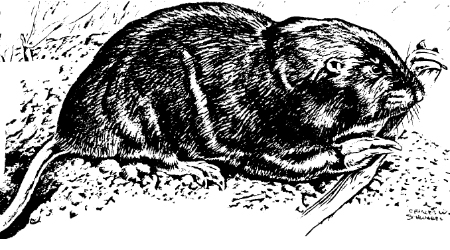
Damage
Prevention and Control Methods
- Exclusion
- Generally not
practical. Small mesh wire fence may provide
protection for ornamental trees and shrubs or flower
beds. Plastic netting protects seedlings.
- Cultural Methods
- Damage resistant
varieties of alfalfa. Crop rotation. Grain buffer
strips. Control of tap-rooted forbs. Flood
irrigation. Plant naturally resistant varieties of
seedlings.
- Repellents
- Synthetic predator
odors are all of questionable benefit.
- Toxicants
- Baits: Strychnine
alkaloid. Zinc phosphide. Chlorophacinone.
Diphacinone.
- Fumigants:
- Carbon monoxide
from engine exhaust. Others are not considered very
- effective, but
some are used: Aluminum phosphide. Gas cartridges.
- Trapping
- Various
specialized gopher kill traps. Common spring or pan
trap (sizes No. 0 and No. 1).
- Shooting
- Not practical.
- Other
- Buried irrigation
pipe or electrical cables can be protected with
cylindrical pipe having an outside diameter of at
least 2.9 inches (7.4 cm).
- Surrounding a
buried cable with 6 to 8 inches (15 to 20 cm) of
coarse gravel (1 inch [2.5 cm] in diameter) may
provide some protection.
Identification
Pocket gophers (Fig. 1)
are fossorial (burrowing) rodents, so named because they
have fur-lined pouches outside of the mouth, one on each
side of the face (Fig. 2). These pockets, which are
capable of being turned inside out, are used for
carrying food. Pocket gophers are powerfully built in
the forequarters and have a short neck; the head is
fairly small and flattened. The forepaws are
large-clawed and the lips close behind their large
incisors, all marvelous adaptations to their underground
existence.
Gophers have small
external ears and small eyes. As sight and sound are
severely limited, gophers are highly dependent on the
sense of touch. The vibrissae (whiskers) on their face
are very sensitive to touch and assist pocket gophers
while traveling about in their dark tunnels. The tail is
sparsely haired and also serves as a sensory mechanism
guiding gophers’ backward movements. The tail is also
important in thermoregulation, acting as a radiator.
Pocket gophers are
medium-sized rodents ranging from about 5 to nearly 14
inches (13 to 36 cm) long (head and body). Adult males
are larger than adult females. Their fur is very fine,
soft, and highly variable in color. Colors range from
nearly black to pale brown to almost white. The great
variability in size and color of pocket gophers is
attributed to their low dispersal rate and thus limited
gene flow, resulting in adaptation to local conditions.
Thirty-four species of
pocket gophers, represented by five genera, occupy the
western hemisphere. In the United States there are 13
species and three genera. The major features
differentiating these genera are the size of their
forefeet, claws, and front surfaces of their chisel-like
incisors (Fig. 3).
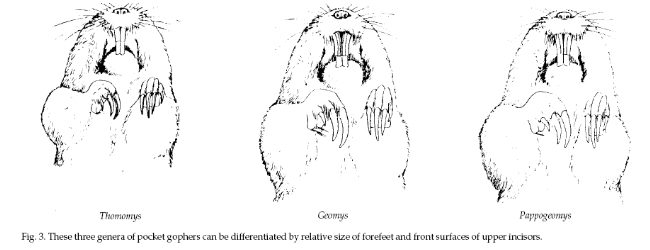
small forefeet with small
claws. Northern pocket gophers (Thomomys talpoides) are
typically from 6 1/2 to 10 inches (17 to 25 cm) long.
Their fur is variable in color but is often yellowish
brown with pale underparts. Botta’s (or valley) pocket
gophers (Thomomys bottae) are extremely variable in size
and color. Botta’s pocket gophers are 5 inches to about
13 1/2 inches (13 to 34 cm) long. Their color varies
from almost white to black.
Geomys
have two grooves on each upper incisor and large
forefeet and claws. Plains pocket gophers (Geomys
bursarius) vary in length from almost 7 1/2 to 14 inches
(18 to 36 cm). Their fur is typically brown but may vary
to black. Desert pocket gophers (Geomys arenarius) are
always brown and vary from nearly 8 3/4 to 11 inches (22
to 28 cm) long. Texas pocket gophers (Geomys personatus)
are also brown and are from slightly larger than 8 3/4
to nearly 13 inches (22 to 34 cm) long. Southeastern
pocket gophers (Geomys pinetis) are of various shades of
brown, depending on soil color, and are from 9 to 13 1/4
inches (23 to 34 cm) long.
Pappogeomys
have a single groove on each upper incisor and, like
Geomys, have large forefeet with large claws.
Yellow-faced pocket gophers (Pappogeomys castanops) vary
in length from slightly more than 5 1/2 to just less
than 7 1/2 inches (14 to 19 cm). Their fur color varies
from pale yellow to dark reddish brown. The underparts
vary from whitish to bright yellowish buff. Some hairs
on the back and top of the head are dark-tipped.
 Range Range
Pocket gophers are found
only in the Western Hemisphere. They range from Panama
in the south to Alberta in the north. With the exception
of the southeastern pocket gopher, they occur throughout
the western two-thirds of the United States.
Plains pocket gophers (Geomys
bursarius, Fig. 4a) are found in the central plains from
Canada south through Texas and Louisiana. Botta’s (or
valley) pocket gophers (Thomomys bottae, Fig. 4a) are
found in most of the southern half of the western United
States.
Northern pocket gophers
(Thomomys talpoides, Fig. 4b) range throughout most of
the states in the northern half of the western United
States. Yellow-faced pocket gophers (Pappogeomys
castanops, Fig. 4b) occur from Mexico, along the western
edge of Texas, eastern New Mexico, southeastern
Colorado, southwestern Kansas, and into the panhandle of
Oklahoma.
Southeastern pocket
gophers (Geomys pinetis, Fig. 4c) are found in northern
and central Florida, southern Georgia, and southeastern
Alabama. Southern pocket gophers (Thomomys umbrinus,
Fig. 4c) range primarily in Central America, but occur
in extreme southwestern New Mexico and southeastern
Arizona. Desert pocket gophers (Geomys arenarius) occur
only in southwestern New Mexico and the extreme western
edge of Texas. Mazama pocket gophers (Thomomys mazama,),
mountain pocket gophers (Thomomys monticola ), and Camas
pocket gophers (Thomomys bulbivorus) have more limited
distributions in the extreme western United States.
Habitat
A wide variety of
habitats are occupied by pocket gophers. They occur from
low coastal areas to elevations in excess of 12,000 feet
(3,600 m). Pocket gophers similarly are found in a wide
variety of soil types and conditions. They reach their
greatest densities on friable, light-textured soils with
good herbage production, especially when that vegetation
has large, fleshy roots, bulbs, tubers, or other
underground storage structures.
The importance of soil
depth and texture to the presence or absence of gophers
is both obvious and cryptic. Shallow soils may be
subject to cave-ins and thus will not maintain a tunnel.
Tunnels are deeper in very sandy soils where soil
moisture is sufficient to maintain the integrity of the
burrow. A less visible requirement is that atmospheric
and exhaled gases must diffuse through the soil to and
from the gopher’s tunnel. Thus light-textured, porous
soils with good drainage allow for good gas exchange
between the tunnel and the atmosphere. Soils that have a
very high clay content or those that are continuously
wet diffuse gases poorly and are unsuitable for gophers.
Pocket gophers
sometimes occupy fairly rocky habitats, although those
habitats generally do not have more than 10% rocks in
the top 8 inches (20 cm) of soil. Pocket gophers appear
to burrow around rocks greater than 1 inch (2.5 cm) in
diameter, but smaller rocks are frequently pushed to the
surface.
Soil depth is also
important in ameliorating temperatures. Soils less than
4 inches (10 cm) deep probably are too warm during
summers. Shallow tunnels may also limit the presence of
gophers during cold temperatures, especially if an
insulating layer of snow is absent.
Typically, only one
species of pocket gopher is found in each locality. Soil
factors are important in limiting the distributions of
pocket gophers. The larger gophers are restricted to
sandy and silty soils east of the Rockies. Smaller
gophers of the genus Thomomys have a broader tolerance
to various soils.
Food
Habits
Pocket gophers feed on
plants in three ways: 1) they feed on roots that they
encounter when digging; 2) they may go to the surface,
venturing only a body length or so from their tunnel
opening to feed on aboveground vegetation; and 3) they
pull vegetation into their tunnel from below. Pocket
gophers eat forbs, grasses, shrubs, and trees. They are
strict herbivores, and any animal material in their diet
appears to result from incidental ingestion.
Alfalfa and dandelions are
apparently some of the most preferred and nutritious
foods for pocket gophers. Generally, Thomomys prefer
perennial forbs, but they will also eat annual plants
with fleshy underground storage structures. Plains
pocket gophers consume primarily grasses, especially
those with rhizomes, but they seem to prefer forbs when
they are succulent in spring and summer.
Portions of plants
consumed also vary seasonally. Gophers utilize
above-ground portions of vegetation mostly during the
growing season, when the vegetation is green and
succulent. Height and density of vegetation at this time
of year may also offer protection from predators,
reducing the risk of short surface trips. Year-round,
however, roots are the major food source. Many trees and
shrubs are clipped just above ground level. This occurs
principally during winter under snow cover. Damage may
reach as high as 10 feet (3 m) above ground. Seedlings
also have their roots clipped by pocket gophers.
Several mammals are
sometimes confused with pocket gophers because of
variations in common local terminology (Fig. 5). In
addition, in the southeastern United States, pocket
gophers are called “salamanders,” (derived from the term
sandy mounder), while the term gopher refers to a
tortoise. Pocket gophers can be distinguished from the
other mammals by their telltale signs as well as by
their appearance. Pocket gophers leave soil mounds on
the surface of the ground. The mounds are usually
fan-shaped and tunnel entrances are plugged, keeping
various intruders out of burrows.
Damage caused by gophers
includes destruction of underground utility cables and
irrigation pipe, direct consumption and smothering of
forage by earthen mounds, and change in species
composition on rangelands by providing seedbeds (mounds)
for invading annual plants. Gophers damage trees by stem
girdling and clipping, root pruning, and possibly root
exposure caused by burrowing. Gopher mounds dull and
plug sicklebars when harvesting hay or alfalfa, and soil
brought to the surface as mounds is more likely to
erode. In irrigated areas, gopher tunnels can channel
water runoff, causing loss of surface irrigation water.
Gopher tunnels in ditch banks and earthen dams can
weaken these structures, causing water loss by seepage
and piping through a bank or the complete loss or
washout of a canal bank. The presence of gophers also
increases the likelihood of badger activity, which can
also cause considerable damage.
Legal Status
Pocket gophers are not
protected by federal or state law.
Exclusion
Because of the expense and
limited practicality, exclusion is of little use.
Fencing of highly valued ornamental shrubs or landscape
trees may be justified. The fence should be buried at
least 18 inches (46 cm). The mesh should be small enough
to exclude gophers: 1/4-inch or 1/2-inch (6- to 13-mm)
hardware cloth will suffice. Cylindrical plastic netting
placed over the entire seedling, including the bare
root, reduces damage to newly planted forest seedlings
significantly.
Cultural Methods and
Habitat Modification
These methods take
advantage of knowledge of the habitat requirements of
pocket gophers or their feeding behavior to reduce or
eliminate damage.
Crop Varieties. In
alfalfa, large tap-rooted plants may be killed or the
vigor of the plant greatly reduced by pocket gophers
feeding on the roots. Varieties with several large roots
rather than a single taproot suffer less when gophers
feed on them. Additionally, pocket gophers in alfalfa
fields with fibrous-root systems may have smaller
ranges. This would reduce gopher impact on yield.
Crop Rotation. There are
many good reasons for using a crop rotation scheme, not
the least of which is minimizing problems with pocket
gophers. When alfalfa is rotated with grain crops, the
resultant habitat is incapable of supporting pocket
gophers. The annual grains do not establish large
underground storage structures and thus there is
insufficient food for pocket gophers to survive
year-round.
Grain Buffer Strips.
Planting 50foot (15-m) buffer strips of grain around hay
fields provides unsuitable habitat around the fields and
can minimize immigration of gophers.
Weed Control. Chemical or
mechanical control of forbs, which frequently have large
underground storage structures, can be an effective
method of minimizing damage by Thomomys to rangelands.
It may also be effective in making orchards and
shelterbelts less suitable for pocket gophers. The
method is less effective for plains pocket gophers as
they survive quite nicely on grasses. The warm-season
prairie grasses have large root-to-stem ratios and these
food sources are adequate for Geomys.
Flood Irrigation.
Irrigating fields by flooding can greatly reduce habitat
suitability for pocket gophers. Water can fill a
gopher’s tunnel, thus causing the occupant to drown or
flee to the surface, making it vulnerable to predation.
The soil may be so damp that it becomes sticky. This
will foul the pocket gopher’s fur and claws. As the soil
becomes saturated with water, the diffusion of gases
into and out of the gopher’s burrow is inhibited,
creating an inhospitable environment. The effectiveness
of this method can be enhanced by removing high spots in
fields that may serve as refuges during irrigation.
Damage-Resistant Plant
Varieties. Tests of several provenances of ponderosa
pine showed that some have natural resistance to gopher
damage.
Repellents
Some predator odors have
been tested as gopher repellents and show some promise.
Commercially available sonic devises are claimed to
repel pocket gophers. There is, however, no scientific
supporting evidence. The plants known as caper spurge,
gopher purge, or mole plant (Euphorbia lathyrus) and the
castor-oil plant (Ricinus communis) have been promoted
as gopher repellents, but there is no evidence of their
effectiveness. In addition, these are not recommended as
they are both poisonous to humans and pets.
Toxicants
Several rodenticides
currently are federally registered and available for
pocket gopher control. The most widely used and
evaluated is strychnine alkaloid (0.25 to 0.5% active
ingredient) on grain baits. There is some concern that
pocket gophers may consume sublethal doses of strychnine
and then develop bait shyness. Strychnine acts very
rapidly and gophers sometimes die within an hour after
consuming a lethal dose. It is registered for use for
Geomys spp. and Thomomys spp. If the label has
directions for use with a burrow builder machine, then
it is a Restricted Use Pesticide. Zinc phosphide (2%) is
less effective than strychnine for gopher control.
Anticoagulants now are available for pocket gopher
control. Currently, the only federally registered
products are chlorophacinone and diphacinone.
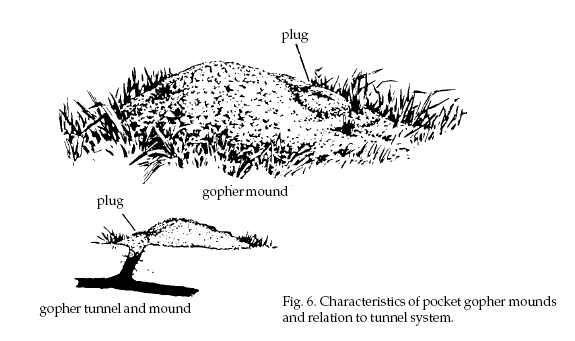
To poison pocket gophers, the bait must be placed in
their tunnel systems by hand or by a special machine
known as a burrow builder. Underground baiting for
pocket gopher control with strychnine presents minimal
hazards to nontarget wildlife, either by direct
consumption of bait or by eating poisoned gophers.
Poison bait spilled on the surface of the ground may be
hazardous to ground-feeding birds such as mourning
doves.
The main drawback to grain
baits is their high susceptibility to decomposition in
the damp burrows. A new product that contains a grain
mixture plus the anticoagulant, diphacinone, in a
paraffin block not only increases the bait’s effective
life, but also makes it possible for more than one
gopher to be killed with the same bait. Once the
resident gopher ingests the toxicant and dies, it is
typical for a neighboring gopher to take over the tunnel
system and thus to ingest the still-toxic bait.
Hand Baiting. Bait can be
placed in a burrow system by hand, using a special
hand-operated bait dispenser probe, or by making an
opening to the burrow system with a probe. Placing bait
in the burrow by hand is more time-consuming than either
of the probing methods, but there is no doubt that the
bait is delivered to the tunnel system.
The key to efficient and
effective use of these methods is locating the burrow
system. The main burrow generally is found 12 to 18
inches (30 to 46 cm) away from the plug on the
fan-shaped mounds (Fig. 6). If you use a trowel or
shovel to locate the main burrow, dig 12 to 18 inches
(30 to 46 cm) away from the plug. When the main burrow
is located, place a rounded tablespoon (15 ml) of bait
in each direction. Place the bait well into each tunnel
system with a long-handled spoon and then block off each
tunnel with sod clumps and soil. Bait blocks are also
applied in this manner. The reason for closing the
burrow is that pocket gophers are attracted to openings
in their system with the intent of closing them with
soil. Thus, if there is a detectable opening near the
placement of poison, the pocket gopher may cover the
bait with soil as it plugs the opening. Pocket gophers
normally travel all portions of their burrow system
during a day.
Place a probe for pocket
gopher tunnels where you expect to locate the main
burrow as described above (plans for making a probe and
instructions for use are presented in figure 7). You
will know you have located a burrow by the decreased
friction on the probe. With a reservoir-type bait probe
dispenser (Fig. 8), a button is pushed when the probe is
in a burrow and a metered dose of bait drops into the
burrow. With the burrow probe (without a bait
reservoir), make an opening from the surface of the
ground to the burrow. Place about a tablespoon (15 ml)
of bait down the probe opening. This method is much
quicker than digging open the burrow tunnel. For best
control, dose each burrow system in two or three places.
Be sure to cover the probe hole with a sod clump so that
the pocket gopher does not cover the bait when attracted
to the opening in its burrow. Greater doses of
chlorophacinone or other locally registered
anticoagulants are recommended (1/2 cup [120 ml]) at
each of two or three locations in each burrow. Also,
since some gophers poisoned in this manner die
aboveground, the area should be checked periodically for
10 to 14 days after treatment. Any dead gophers found
should be buried or incinerated.
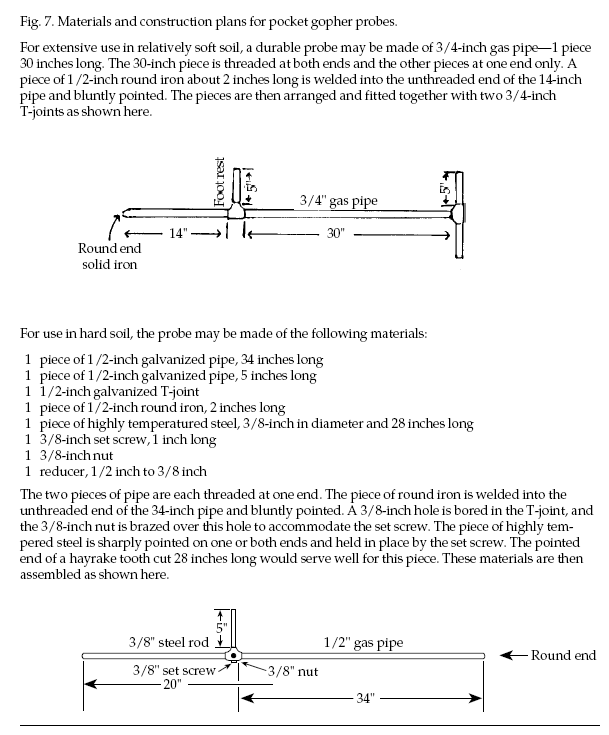
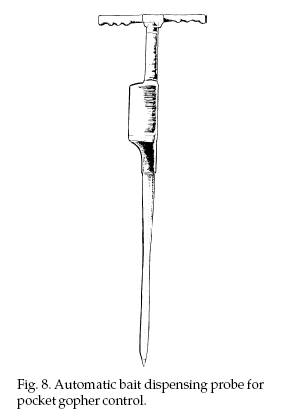 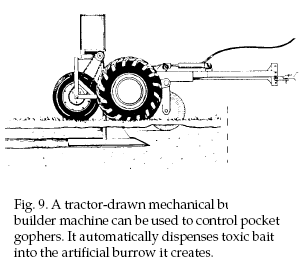
Mechanical Burrow Builder.
The burrow builder (Fig. 9) delivers bait underground
mechanically, so large areas can be economically treated
for pocket gopher control. It is tractor-drawn and is
available in hydraulically operated units or three-point
hitch models.
The device consists of a
knife and torpedo assembly that makes the artificial
burrow at desired soil depths, a coulter blade that cuts
roots of plants ahead of the knife, a seeder assembly
for bait dispensing, and the packer wheel assembly to
close the burrow behind the knife. The seeder box has a
metering device for dispensing various toxic baits at
desired rates.
The artificial burrows
should be constructed at a depth similar to those
constructed by gophers in your area. The artificial
burrows may intercept the gopher burrows, or the gophers
may inquisitively enter the artificial burrows, gather
bait in their cheek pouches, and return to their burrow
system to consume the bait. Recommended application
rates of 1 to 2 pounds per acre (1.1 to 2.2 kg/ha) of
0.3 to 0.5% strychnine alkaloid grain should provide an
85% to 95% reduction in the gopher population (Table 1
demonstrates how to calculate bait delivery rates). The
burrows should be spaced at 20- to 25-foot (6- to 8-m)
intervals. To assure success:
Operate the burrow builder
parallel to the ground surface, at a depth where gophers
are active. It is essential to check the artificial
burrow. If the soil is too dry, a good burrow will not
be formed; if the soil is too wet and sticky, soil will
accumulate on packer wheels or even on the knife shank
and the slot may not close adequately.
Check periodically to note
whether bait is being dispensed. Sometimes the tube gets
clogged with soil.
Encircle the perimeter of
the field with artificial burrows to deter reinvasions.
Follow directions provided
with the burrow builder machine. It is especially
important to scour the torpedo assembly by pulling it
through sandy soils so that smooth burrows will be
constructed.
It is especially important
to scour the torpedo assembly by pulling it through
sandy soils so that smooth burrows will be constructed.
EXAMPLE: To determine the
amount of bait that will be delivered if a mechanical
baiter is set to apply 0.5 pound per 1,000 feet of
burrow, and is to be used between orchard rows with
22-foot spacings, read down row spacing column 22 until
opposite the designated 0.5 pound. The answer (to the
nearest hundredth) is 0.99 pound.
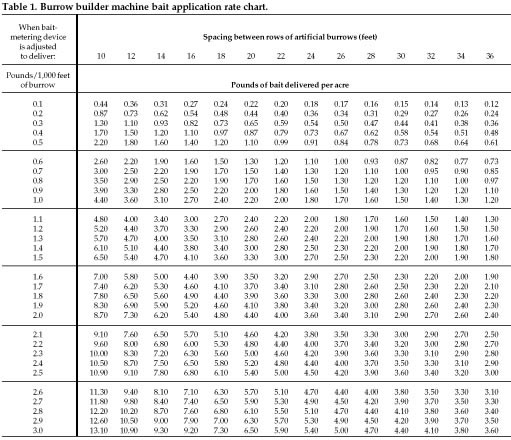
Fumigants
Federally registered
fumigants include aluminum phosphide and gas cartridges
with various active ingredients. These fumigants usually
are not very successful in treating pocket gophers
because the gas moves too slowly through the tunnel
system. Unless the soil is moist, the fumigant will
diffuse through the soil out of the gopher’s tunnel.
Carbon monoxide from
automobile exhaust is more effective than other
fumigants because of its greater volume and pressure.
Connect a piece of hose or pipe to the engine exhaust,
and place it in a tunnel near a fresh soil mound. Pack
soil around the hose or pipe and allow the engine to run
for about 3 minutes. The method is usually 90%
effective. The engines of newer vehicles with
antipollution devices require a longer running time
since they do not produce as much carbon monoxide. This
procedure requires no registration.
Trapping
Trapping is extremely
effective for pocket gopher control in small areas and
for removal of remaining animals after a poisoning
control program. Some representative traps are
illustrated on the following page (Fig. 10) with
instructions for setting them (Figs. 11 and 12).
Vulnerability to trapping
differs among species of pocket gophers and sometimes
within the same species in different areas and at
different times of the year.
For effective trapping,
the first requisite is to find the tunnel. The procedure
will vary depending on whether traps are set in the main
tunnel or in the lateral tunnels (Fig. 13). To locate
traps in the main tunnel, refer to the section on hand
baiting. To locate the lateral tunnels, find a fresh
mound and with a trowel or shovel, dig several inches
away from the mound on the plug side. The lateral may be
plugged with soil for several inches (cm) or several
feet (m). However, fresh mounds are usually plugged only
a few inches.


You may have to experiment
with trap type and placement. Some trappers have success
leaving tunnels completely open when they set their
traps; others, when they place traps in the main, close
off the tunnel completely, and when trapping the
lateral, close most of the tunnel with sod. Traps can be
marked above ground with engineering flags and should be
anchored with a stake and wire or chain so a predator
does not carry off the catch and the trap.
Trapping can be done
year-round because gophers are always active, but a
formidable effort is required for trapping when the soil
is frozen. Trapping is most effective when gophers are
pushing up new mounds, generally in spring and fall. If
a trap is not visited within 48 hours, move it to a new
location. Leave traps set in a tunnel system even if you
have trapped a gopher in spring and early summer, when
gophers are most likely to share their quarters.
Shooting
Since pocket gophers spend
essentially all their time below ground, this method is
impractical.
Other
Methods
Buried utility cables and
irrigation lines can be protected by enclosing them in
various materials, as long as the outside diameter
exceeds 2.9 inches (7.4 cm). Gophers can open their
mouths only wide enough to allow about a 1-inch (2.5-cm)
span between the upper and lower incisors. Thus, the
recommended diameter presents an essentially flat
surface to most pocket gophers. Cables can be protected
in this manner whether they are armored or not. Soft
metals such as lead and aluminum used for armoring
cables are readily damaged by pocket gophers if the
diameters are less than the suggested sizes.
Buried cables may be
protected from gopher damage by surrounding the cable
with 6 to 8 inches (15 to 20 cm) of coarse gravel.
Pocket gophers usually burrow around gravel 1 inch (2.5
cm) in diameter, whereas smaller pebbles may be pushed
to the surface.
Economics of Damage and Control
It is relatively easy to
determine the value of the forage lost to pocket
gophers. Botta’s pocket gophers at a density of 32 per
acre (79/ha) decreased the forage yield by 25% on
foothill rangelands in California, where the plants were
nearly all annuals. Plains pocket gophers reduced forage
yield on rangelands in western Nebraska by 21% to 49% on
different range sites. Alfalfa yields in eastern
Nebraska were reduced as much as 46% in dryland and 35%
in irrigated alfalfa. Losses of 30% have been reported
for hay meadows.
Calculating the cost of
control operations is only slightly more complicated.
However, the benefit-cost analysis of control is still
not straightforward. More research data are needed on
managing the recovery of forage productivity. For
example, should range be fertilized, rested, or lightly
grazed? Should gopher mounds on alfalfa be lightly
harrowed? A study of northern pocket gopher control on
range production in southern Alberta indicated that
forage yields increased 16%, 3 months after treatment.
The potential for complete yield recovery the first year
following gopher removal has been noted for a
fibrous-rooted variety of alfalfa.
Economic assessment should
also be made to determine the cost of no control, the
speed of pocket gopher infestation, and the costs
associated with dulled or plugged mowing machinery or
mechanical breakdowns caused by the mounds. Assessment
could also be made for damages to buried cable,
irrigation structures, trees, and so on.
The benefits of pocket
gophers also complicate the economic analysis. Some of
these benefits are: (1) increased soil fertility by
adding organic matter such as buried vegetation and
fecal wastes; (2) increased soil aeration and decreased
soil compaction; (3) increased water infiltration and
thus decreased runoff; and (4) increased rate of soil
formation by bringing subsoil material to the surface of
the ground, subjecting it to weathering.
Decisions on whether or
not to control gophers may be influenced by the animals’
benefits, which are long-term and not always readily
recognized, and the damage they cause, which is obvious
and sometimes substantial in the short-term. Landowners
who are currently troubled by pocket gophers can gain
tremendously by studying the gophers’ basic biology.
They would gain economically by learning how to manage
their systems with pocket gophers in mind, and
aesthetically by understanding how this interesting
animal “makes a living.”
The distribution of
gophers makes it unlikely that control measures will
threaten them with extinction. Local eradication may be
desirable and cost-effective in some small areas with
high-value items. On the other hand, it may be effective
to simply reduce a population. There are also times when
control is not cost-effective and therefore inadvisable.
Complete control may upset the long-term integrity of
ecosystems in a manner that we cannot possibly predict
from our current knowledge of the structure and function
of those systems.
Acknowledgments
We thank the many
researchers and managers who have spent untold time
studying these extremely interesting rodents. Some are
listed in the reference section. Special thanks are due
to Scott Hygnstrom for his editorial assistance; to Rex
E. Marsh, Bob Timm, and Jan Hygnstrom for their helpful
comments on an earlier draft, and to Diane Gronewold and
Diana Smith for their technical assistance.
Figures 1, 2, and 6 from
Schwartz and Schwartz (1981).
Figures 3 and 5 from
Turner et al. (1973).
Figures 4a, 4b, and 4c
after Hegdal and Harbour (1991), adapted by BruceJasch
and Dave Thornhill.
Figures 7, 8, and 10 by
Jill Sack Johnson.
Figure 9 courtesy of
Elston Equipment Company.
Figure 11 courtesy of Z.
A. Macabee Gopher Trap Company.
Figure 12 courtesy of P-W
Manufacturing Company.
Figure 13 adapted from E.
K. Boggess (1980), “Pocket Gophers,” in Handbook on
Prevention and Control of Wildlife Damage, Kansas State
University, Manhattan.
Table 1 taken from Marsh
and Cummings (1977).
PREVENTION AND CONTROL OF
WILDLIFE DAMAGE — 1994
Cooperative Extension
Division Institute of Agriculture and Natural Resources
University of Nebraska -Lincoln
United States Department
of Agriculture Animal and Plant Health Inspection
Service Animal Damage Control
Great Plains Agricultural
Council Wildlife Committee
11/14/2006
Special
thanks to:
Clemson University
|